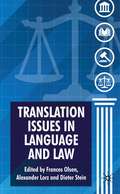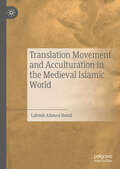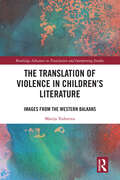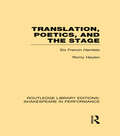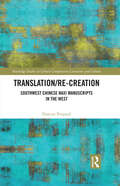- Table View
- List View
Translation into the Second Language (Applied Linguistics and Language Study)
by Stuart CampbellThe dynamics of immigration, international commerce and the postcolonial world make it inevitable that much translation is done into a second language, despite the prevailing wisdom that translators should only work into their mother tongue. This book is the first study to explore the phenomenon of translation into a second language in a way that will interest applied linguists, translators and translation teachers, and ESOL teachers working with advanced level students. Rather than seeing translation into a second language as deficient output, this study adopts an interlanguage framework to consider L2 translation as the product of developing competence; learning to translate is seen as a special variety of second language acquisition. Through carefully worked case studies, separate components of translation competence are identified, among them the ability to create stylistically authentic texts in English, the ability to monitor and edit output, and the psychological attitudes that the translator brings to the task. While the case studies mainly deal with Arabic speakers undergoing translator training in Australia, the conclusions will have implications for translation into a second language, especially English, around the world. Translation into the Second Language is firmly grounded in empirical research, and in this regard it serves as a stimulus and a methodological guide for further research. It will be a valuable addition for advanced undergraduate and postgraduate students of applied linguistics, translation theory, bilingualism and second language acquisition as well as those involved in teaching or practicing translation at a professional level.
Translation into the Second Language (Applied Linguistics and Language Study)
by Stuart CampbellThe dynamics of immigration, international commerce and the postcolonial world make it inevitable that much translation is done into a second language, despite the prevailing wisdom that translators should only work into their mother tongue. This book is the first study to explore the phenomenon of translation into a second language in a way that will interest applied linguists, translators and translation teachers, and ESOL teachers working with advanced level students. Rather than seeing translation into a second language as deficient output, this study adopts an interlanguage framework to consider L2 translation as the product of developing competence; learning to translate is seen as a special variety of second language acquisition. Through carefully worked case studies, separate components of translation competence are identified, among them the ability to create stylistically authentic texts in English, the ability to monitor and edit output, and the psychological attitudes that the translator brings to the task. While the case studies mainly deal with Arabic speakers undergoing translator training in Australia, the conclusions will have implications for translation into a second language, especially English, around the world. Translation into the Second Language is firmly grounded in empirical research, and in this regard it serves as a stimulus and a methodological guide for further research. It will be a valuable addition for advanced undergraduate and postgraduate students of applied linguistics, translation theory, bilingualism and second language acquisition as well as those involved in teaching or practicing translation at a professional level.
Translation Issues in Language and Law
by F. Olsen R. Lorz D. SteinWith contributions from world-class specialists this first book-length work looks at translation issues in forensic linguistics, where accuracy and cultural understandings play a prominent part in the legal process.
Translation Movement and Acculturation in the Medieval Islamic World
by Labeeb Ahmed BsoulThis book investigates the transmission of knowledge in the Arab and Islamic world, with particular attention to the translation of material from Greek, Persian, and Sanskrit into Arabic, and then from Arabic into Latin in medieval Western Europe. While most modern scholarly works have addressed contributions of Muslim scholars to the modern development of translation, Labeeb Ahmed Bsoul bases his study on Arabic classical literature and its impact upon modern translation. He focuses on the contributions made by prominent classical Christian and Muslim scholars, showcasing how their works and contributions to the field of knowledge are still relevant today.
Translation of Contemporary Taiwan Literature in a Cross-Cultural Context: A Translation Studies Perspective (Routledge Studies in Chinese Translation)
by Szu-Wen KungTranslation of Contemporary Taiwan Literature in a Cross-Cultural Context explores the social, cultural, and linguistic implications of translation of Taiwan literature for transnational cultural exchange. It demonstrates principally how asymmetrical cultural relationships, mediation processes, and ideologies of the translation players constitute the culture-specific translation activity as a highly contested site, where translation can reconstruct and rewrite the literature and the culture it represents. Four main theoretical themes are explored in relation to such translation activity: sociological studies, cultural and rewriting studies, English as a lingua franca, and social and performative linguistics. These offer insightful perspectives on the translation as an interpretive encounter between not only two languages, two cultural systems and assumptions taking place, but also among various translation mediators. This book will be useful to scholars and students working on translation and cultural studies, China/Taiwan literature studies, and literature studies in cross-cultural contexts.
The Translation of Realia and Irrealia in Game Localization: Culture-Specificity between Realism and Fictionality (Routledge Advances in Translation and Interpreting Studies)
by Silvia PettiniThis book explores the impact of a video game’s degree of realism or fictionality on its linguistic dimensions, investigating the challenges and strategies for translating realia and irrealia, the interface of the real world and the game world where culture-specificity manifests itself. The volume outlines the key elements in the translation of video games, such as textual non-linearity, multitextuality, and playability, and introduces the theoretical framework used to determine a game’s respective degree of realism or fictionality. Pettini applies an interdisciplinary approach drawing on video game research and Descriptive Translation Studies to the linguistic and translational analysis of in-game dialogs in English-Italian and English-Spanish language pairs from a corpus of three war video games. This approach allows for an in-depth look at the localization challenges posed by the varying degree of realism and fictionality across video games and the different strategies translators employ in response to these challenges. A final chapter offers a comparative analysis of the three games and subsequently avenues for further research on the role of culture-specificity in game localization. This book is key reading for students and scholars interested in game localization, audiovisual translation studies, and video game research.
The Translation of Realia and Irrealia in Game Localization: Culture-Specificity between Realism and Fictionality (Routledge Advances in Translation and Interpreting Studies)
by Silvia PettiniThis book explores the impact of a video game’s degree of realism or fictionality on its linguistic dimensions, investigating the challenges and strategies for translating realia and irrealia, the interface of the real world and the game world where culture-specificity manifests itself. The volume outlines the key elements in the translation of video games, such as textual non-linearity, multitextuality, and playability, and introduces the theoretical framework used to determine a game’s respective degree of realism or fictionality. Pettini applies an interdisciplinary approach drawing on video game research and Descriptive Translation Studies to the linguistic and translational analysis of in-game dialogs in English-Italian and English-Spanish language pairs from a corpus of three war video games. This approach allows for an in-depth look at the localization challenges posed by the varying degree of realism and fictionality across video games and the different strategies translators employ in response to these challenges. A final chapter offers a comparative analysis of the three games and subsequently avenues for further research on the role of culture-specificity in game localization. This book is key reading for students and scholars interested in game localization, audiovisual translation studies, and video game research.
The Translation of Violence in Children’s Literature: Images from the Western Balkans (Routledge Advances in Translation and Interpreting Studies)
by Marija TodorovaConsidering children’s literature as a powerful repository for creating and proliferating cultural and national identities, this monograph is the first academic study of children’s literature in translation from the Western Balkans. Marija Todorova looks at a broad range of children’s literature, from fiction to creative non-fiction and picture books, across five different countries in the Western Balkans, with each chapter including detailed textual and visual analysis through the predominant lens of violence. These chapters raise questions around who initiates and effectuates the selection of children’s literature from the Western Balkans for translation into English, and interrogate the role of different stakeholders, such as translators, publishers and cultural institutions in the representation and construction of these countries in translated children’s literature, both in text and visually. Given the combination of this study’s interdisciplinary nature and Todorova’s detailed analysis, this book will prove to be an essential resource for professional translators, researchers and students in courses in translation studies, children’s literature or area studies, especially that of countries in the Western Balkans. .
The Translation of Violence in Children’s Literature: Images from the Western Balkans (Routledge Advances in Translation and Interpreting Studies)
by Marija TodorovaConsidering children’s literature as a powerful repository for creating and proliferating cultural and national identities, this monograph is the first academic study of children’s literature in translation from the Western Balkans. Marija Todorova looks at a broad range of children’s literature, from fiction to creative non-fiction and picture books, across five different countries in the Western Balkans, with each chapter including detailed textual and visual analysis through the predominant lens of violence. These chapters raise questions around who initiates and effectuates the selection of children’s literature from the Western Balkans for translation into English, and interrogate the role of different stakeholders, such as translators, publishers and cultural institutions in the representation and construction of these countries in translated children’s literature, both in text and visually. Given the combination of this study’s interdisciplinary nature and Todorova’s detailed analysis, this book will prove to be an essential resource for professional translators, researchers and students in courses in translation studies, children’s literature or area studies, especially that of countries in the Western Balkans. .
Translation, Poetics, and the Stage: Six French Hamlets (Routledge Library Editions: Shakespeare in Performance)
by Romy HeylenThis book establishes an analytical model for the description of existing translations in their historical context within a framework suggested by systemic concepts of literature. It argues against mainstream 20th-century translation theory and, by proposing a socio-cultural model of translation, takes into account how a translation functions in the receiving culture. The case studies of successive translations of "Hamlet" in France from the eighteenth century neoclassical version of Jean-Francois Ducis to the 20th-century Lacanian, post-structuralist stage production of Daniel Mesguich show the translator at work. Each chapter focuses on a different aspect of the changing theatrical and literary norms to which translators through the ages have been bound by the expectations both of their audiences and the literary establishment.
Translation, Poetics, and the Stage: Six French Hamlets (Routledge Library Editions: Shakespeare in Performance)
by Romy HeylenThis book establishes an analytical model for the description of existing translations in their historical context within a framework suggested by systemic concepts of literature. It argues against mainstream 20th-century translation theory and, by proposing a socio-cultural model of translation, takes into account how a translation functions in the receiving culture. The case studies of successive translations of "Hamlet" in France from the eighteenth century neoclassical version of Jean-Francois Ducis to the 20th-century Lacanian, post-structuralist stage production of Daniel Mesguich show the translator at work. Each chapter focuses on a different aspect of the changing theatrical and literary norms to which translators through the ages have been bound by the expectations both of their audiences and the literary establishment.
Translation Project Management (Routledge Introductions to Translation and Interpreting)
by Callum WalkerThis textbook provides a comprehensive overview of the processes, principles, and constraints of project management in the translation industry. It offers readers clear insights into modern-day project management practices specific to translation services and an understanding of critical inter-related aspects of the process, drawing on key works in business studies on management, aspects of economics relevant to project management, and international standards on project management processes. Developed on the back of a successful module titled Intercultural Project Management, Translation Project Management provides a coherent account of the entire translation project management lifecycle from start to finish and pays considerable attention to the factors influencing decision- making at various stages and how external forces shape the way in which a translation project plays out. Through an array of real-world case studies, it offers readers opportunities to explore, analyse, and engage with six fundamental project constraints: cost, time, scope, quality, benefits, and risk. Each chapter offers discussion points, possible assignments, and guided further reading. This is an essential textbook both for all project management courses within translation studies programmes and for professional translators and translation service providers.
Translation Project Management (Routledge Introductions to Translation and Interpreting)
by Callum WalkerThis textbook provides a comprehensive overview of the processes, principles, and constraints of project management in the translation industry. It offers readers clear insights into modern-day project management practices specific to translation services and an understanding of critical inter-related aspects of the process, drawing on key works in business studies on management, aspects of economics relevant to project management, and international standards on project management processes. Developed on the back of a successful module titled Intercultural Project Management, Translation Project Management provides a coherent account of the entire translation project management lifecycle from start to finish and pays considerable attention to the factors influencing decision- making at various stages and how external forces shape the way in which a translation project plays out. Through an array of real-world case studies, it offers readers opportunities to explore, analyse, and engage with six fundamental project constraints: cost, time, scope, quality, benefits, and risk. Each chapter offers discussion points, possible assignments, and guided further reading. This is an essential textbook both for all project management courses within translation studies programmes and for professional translators and translation service providers.
Translation Quality Assessment: Past and Present
by Juliane HouseTranslation Quality Assessment has become one of the key issues in translation studies. This comprehensive and up-to-date treatment of translation evaluation makes explicit the grounds of judging the worth of a translation and emphasizes that translation is, at its core, a linguistic art. Written by the author of the world’s best known model of translation quality assessment, Juliane House provides an overview of relevant contemporary interdisciplinary research on intercultural communication and globalization research, corpus and psycho- and neurolinguistic studies. House also acknowledges the importance of socio-cultural and situational context in which texts are embedded, and which need to be analysed when they are transferred through space and time in acts of translation but also highlights the linguistic art form of translation. The text includes a newly revised and presented model of translation quality assessment which, like its predecessor, relies on detailed textual and culturally informed contextual analysis and comparison. The test cases also show that there are two steps in translation evaluation: firstly analysis, description and explanation; secondly, judgements of value, socio-cultural relevance and appropriateness. The second is futile without the first: to judge is easy, to understand less so. Translation Quality Assessment is an invaluable resource for students and researchers of Translation Studies and Intercultural Communication, as well as for professional translators.
Translation Quality Assessment: Past and Present
by Juliane HouseTranslation Quality Assessment has become one of the key issues in translation studies. This comprehensive and up-to-date treatment of translation evaluation makes explicit the grounds of judging the worth of a translation and emphasizes that translation is, at its core, a linguistic art. Written by the author of the world’s best known model of translation quality assessment, Juliane House provides an overview of relevant contemporary interdisciplinary research on intercultural communication and globalization research, corpus and psycho- and neurolinguistic studies. House also acknowledges the importance of socio-cultural and situational context in which texts are embedded, and which need to be analysed when they are transferred through space and time in acts of translation but also highlights the linguistic art form of translation. The text includes a newly revised and presented model of translation quality assessment which, like its predecessor, relies on detailed textual and culturally informed contextual analysis and comparison. The test cases also show that there are two steps in translation evaluation: firstly analysis, description and explanation; secondly, judgements of value, socio-cultural relevance and appropriateness. The second is futile without the first: to judge is easy, to understand less so. Translation Quality Assessment is an invaluable resource for students and researchers of Translation Studies and Intercultural Communication, as well as for professional translators.
Translation Quality Assessment: From Principles to Practice (Machine Translation: Technologies and Applications #1)
by Joss Moorkens Sheila Castilho Federico Gaspari Stephen DohertyThis is the first volume that brings together research and practice from academic and industry settings and a combination of human and machine translation evaluation. Its comprehensive collection of papers by leading experts in human and machine translation quality and evaluation who situate current developments and chart future trends fills a clear gap in the literature. This is critical to the successful integration of translation technologies in the industry today, where the lines between human and machine are becoming increasingly blurred by technology: this affects the whole translation landscape, from students and trainers to project managers and professionals, including in-house and freelance translators, as well as, of course, translation scholars and researchers. The editors have broad experience in translation quality evaluation research, including investigations into professional practice with qualitative and quantitative studies, and the contributors are leading experts in their respective fields, providing a unique set of complementary perspectives on human and machine translation quality and evaluation, combining theoretical and applied approaches.
Translation/re-Creation: Southwest Chinese Naxi Manuscripts in the West (Routledge Studies in Chinese Comparative Literature and Culture)
by Duncan PoupardThis book is a study of European-language translations of Naxi ritual manuscripts, the ritual literature of a small ethnic group living in southwest China’s Yunnan Province. The author discusses the translations into European languages (in English, French and German) from the late nineteenth century to the second half of the twentieth century, revealing a history of fragmentary yet interconnected translation efforts in the West. By exploring this network, he shows how translation can be understood as a metonymic “recreation” of textual worlds. As Naxi manuscripts are semi-oral texts representing an oral-formulaic tradition, their translation involves a metonymic relay of partial incorporations from manuscript/image to reading/spoken language. Therefore, the book engages in a series of textual excavations to uncover the previously occluded contemporaneous readings that would have led to the translations we can consult today, particularly in an attempt to understand how the Naxi literature came to be part of Ezra Pound’s Cantos. Scholars in the field of ethnic minority literature in China and translation studies will find this book beneficial, and it will make new contributions to comparative literature between the East and West.
Translation/re-Creation: Southwest Chinese Naxi Manuscripts in the West (Routledge Studies in Chinese Comparative Literature and Culture)
by Duncan PoupardThis book is a study of European-language translations of Naxi ritual manuscripts, the ritual literature of a small ethnic group living in southwest China’s Yunnan Province. The author discusses the translations into European languages (in English, French and German) from the late nineteenth century to the second half of the twentieth century, revealing a history of fragmentary yet interconnected translation efforts in the West. By exploring this network, he shows how translation can be understood as a metonymic “recreation” of textual worlds. As Naxi manuscripts are semi-oral texts representing an oral-formulaic tradition, their translation involves a metonymic relay of partial incorporations from manuscript/image to reading/spoken language. Therefore, the book engages in a series of textual excavations to uncover the previously occluded contemporaneous readings that would have led to the translations we can consult today, particularly in an attempt to understand how the Naxi literature came to be part of Ezra Pound’s Cantos. Scholars in the field of ethnic minority literature in China and translation studies will find this book beneficial, and it will make new contributions to comparative literature between the East and West.
Translation, Reception and Canonization of The Art of War: Reviving Ancient Chinese Strategic Culture (Routledge Advances in Translation and Interpreting Studies)
by Tian LuoThe Art of War by Sun Tzu is an ancient yet invaluable Chinese military classic that is still relevant today. This book presents a systematic and in-depth investigation into the translation and reception of The Art of War in the western strategic culture. Aided by three self-built corpora, this study adopts a mixed method including both qualitative and quantitative analysis, and aking takes both the core text and its paratexts of The Art of War into consideration. This study highlights the significance of proper approaches to translating culture in the core text and effective measures of culture reconstruction in paratexts. It is revealed that the translated Sun Tzu has undergone three major stages before it is gradually welcomed and re-canonized in western discourse. The findings bring into light the multiple factors that contribute to the incorporation of Sun Tzu’s strategic wisdom into western culture. For scholars interested in translation studies, (critical) discourse analysis as well as strategic studies, this book provides fresh insights and new perspectives.
Translation, Reception and Canonization of The Art of War: Reviving Ancient Chinese Strategic Culture (Routledge Advances in Translation and Interpreting Studies)
by Tian LuoThe Art of War by Sun Tzu is an ancient yet invaluable Chinese military classic that is still relevant today. This book presents a systematic and in-depth investigation into the translation and reception of The Art of War in the western strategic culture. Aided by three self-built corpora, this study adopts a mixed method including both qualitative and quantitative analysis, and aking takes both the core text and its paratexts of The Art of War into consideration. This study highlights the significance of proper approaches to translating culture in the core text and effective measures of culture reconstruction in paratexts. It is revealed that the translated Sun Tzu has undergone three major stages before it is gradually welcomed and re-canonized in western discourse. The findings bring into light the multiple factors that contribute to the incorporation of Sun Tzu’s strategic wisdom into western culture. For scholars interested in translation studies, (critical) discourse analysis as well as strategic studies, this book provides fresh insights and new perspectives.
Translation Revision and Post-editing: Industry Practices and Cognitive Processes
by Maarit Koponen Brian Mossop Giovanna Scocchera Isabelle S. RobertTranslation Revision and Post-editing looks at the apparently dissolving boundary between correcting translations generated by human brains and those generated by machines. It presents new research on post-editing and revision in government and corporate translation departments, translation agencies, the literary publishing sector and the volunteer sector, as well as on training in both types of translation checking work.This collection includes empirical studies based on surveys, interviews and keystroke logging, as well as more theoretical contributions questioning such traditional distinctions as translating versus editing. The chapters discuss revision and post-editing involving eight languages: Afrikaans, Catalan, Dutch, English, Finnish, French, German and Spanish. Among the topics covered are translator/reviser relations and revising/post-editing by non-professionals.The book is key reading for researchers, instructors and advanced students in Translation Studies as well as for professional translators with a special interest in checking translations.
Translation Revision and Post-editing: Industry Practices and Cognitive Processes
by Maarit Koponen; Brian Mossop; Isabelle S. Robert; Giovanna ScoccheraTranslation Revision and Post-editing looks at the apparently dissolving boundary between correcting translations generated by human brains and those generated by machines. It presents new research on post-editing and revision in government and corporate translation departments, translation agencies, the literary publishing sector and the volunteer sector, as well as on training in both types of translation checking work.This collection includes empirical studies based on surveys, interviews and keystroke logging, as well as more theoretical contributions questioning such traditional distinctions as translating versus editing. The chapters discuss revision and post-editing involving eight languages: Afrikaans, Catalan, Dutch, English, Finnish, French, German and Spanish. Among the topics covered are translator/reviser relations and revising/post-editing by non-professionals.The book is key reading for researchers, instructors and advanced students in Translation Studies as well as for professional translators with a special interest in checking translations.
Translation, Rewriting, and the Manipulation of Literary Fame (Routledge Translation Classics)
by Andre LefevereOne of the first books to shine a light on the broad scope of translation studies, this Routledge Translation Classic is widely regarded as a pillar of the discipline. Authored by one of the most infl uential translation theorists of the twentieth century, Translation, Rewriting, and the Manipulation of Literary Fame shows how rewriting – translation, anthologization, historiography, criticism, editing – infl uences the reception and canonization of works of literature. Firmly placing the production and reception of literature within the wider framework of a culture and its history, André Lefevere explores how rewriting manipulates works of literature to ideological and artistic ends, and demonstrates how rewriting a text can give it a new, sometimes subversive, historical or literary status. Ranging across various literatures, including Classical Latin, French, and German, and here reissued with a new foreword by Scott G. Williams, this is a seminal text for all students and specialists in translation studies, literary theory, and comparative and world literature.
Translation, Rewriting, and the Manipulation of Literary Fame (Routledge Translation Classics)
by Andre LefevereOne of the first books to shine a light on the broad scope of translation studies, this Routledge Translation Classic is widely regarded as a pillar of the discipline. Authored by one of the most infl uential translation theorists of the twentieth century, Translation, Rewriting, and the Manipulation of Literary Fame shows how rewriting – translation, anthologization, historiography, criticism, editing – infl uences the reception and canonization of works of literature. Firmly placing the production and reception of literature within the wider framework of a culture and its history, André Lefevere explores how rewriting manipulates works of literature to ideological and artistic ends, and demonstrates how rewriting a text can give it a new, sometimes subversive, historical or literary status. Ranging across various literatures, including Classical Latin, French, and German, and here reissued with a new foreword by Scott G. Williams, this is a seminal text for all students and specialists in translation studies, literary theory, and comparative and world literature.
Translation, Semiotics, and Feminism: Selected Writings of Barbara Godard (Key Thinkers on Translation)
by Eva C. Karpinski Elena BasileTranslation, Semiotics, and Feminism: Selected Writings of Barbara Godard brings together 16 of the most important essays by the influential Canadian scholar, situating her thinking in relation to feminism and translation studies from the 1980s through the 2000s. Godard’s lasting contributions helped to advance several areas in translation studies such as feminist theories and semiotics.The collection includes two previously unpublished essays and two essays that have so far only appeared in French. The book is organized into four thematic parts covering feminist theories, comparative cultural studies, semiotics and ethics, and embodied praxis of translation. Each part is accompanied by specifically focused introductory essays, written by the editors, elucidating the material presented in each section. Topics range from translating and sexual difference and feminist discourse to translation and theatre and the ethics of translating. This timely book is key reading for scholars, researchers, and advanced students of translation studies, comparative literature, gender studies, and cultural studies.

